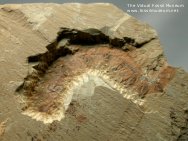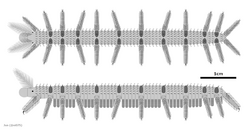Biology:Onychodictyon
| Onychodictyon | |
|---|---|

| |
| Onychodictyon ferox fossil from Chengjiang | |
| Scientific classification | |
| Domain: | Eukaryota |
| Kingdom: | Animalia |
| (unranked): | Panarthropoda |
| Phylum: | †"Lobopodia" |
| Class: | †Xenusia |
| Order: | †Paronychophora |
| Family: | †Onychodictyidae |
| Genus: | †Onychodictyon Hou, Ramsköld, & Bergström, 1991 |
| Type species | |
| Onychodictyon ferox Hou, Ramsköld, & Bergström, 1991
| |
| Species | |
| |
Onychodictyon is a genus of extinct lobopodian known from the Lower Cambrian Chengjiang Maotianshan Shales in the Yunnan Province in China.[1] It was characterized by a stout body covered by fleshy papillae and pairs of sclerotized plates with spines,[2][1][3] representing part of the diverse "armoured lobopodians" alongside similar forms such as Microdictyon and Hallucigenia.[1]
The maximum length of Onychodictyon is 70 mm (2.8 in).[1] It has a resemblance to Microdictyon (net-like sclerite ornament)[4] but also Aysheaia and tardigrade (basally-fused terminal leg pair).[5] Each leg have a pair of curved claws that are thought to have aided Onychodictyon climb onto other organisms.[6] Onychodictyon sclerites appear to have molted with some specimens exhibiting perfectly conjoined plates from successive molts.[7]
Onychodictyon is represented by two species: O. ferox which has a pair of simple eyes and feathery antenniform appendages on its head;[3] and O. gracilis which has a blunt front end without evidence of any appendages.[1]
References
- ↑ Jump up to: 1.0 1.1 1.2 1.3 1.4 Liu, Jianni; Shu, Degan; Han, Jian; Zhang, Zhifei; Zhang, Xingliang (2008). "The lobopod "Onychodictyon" from the Lower Cambrian Chengjiang Lagerstätte revisited". Acta Palaeontologica Polonica 53 (2): 285–292. doi:10.4202/app.2008.0209. https://www.app.pan.pl/archive/published/app53/app53-285.pdf.
- ↑ Ramsköld, L.; Xianguang, Hou (1991). "New early Cambrian animal and onychophoran affinities of enigmatic metazoans" (in en). Nature 351 (6323): 225–228. doi:10.1038/351225a0. ISSN 1476-4687. https://www.nature.com/articles/351225a0.
- ↑ Jump up to: 3.0 3.1 Ou, Qiang; Shu, Degan; Mayer, Georg (2012). "Cambrian lobopodians and extant onychophorans provide new insights into early cephalization in Panarthropoda" (in en). Nature Communications 3 (1): 1261. doi:10.1038/ncomms2272. ISSN 2041-1723. PMID 23232391.
- ↑ Steiner, M.; Hu, S.X.; Liu, J.; Keupp, H. (2012-02-02). "A new species of Hallucigenia from the Cambrian Stage 4 Wulongqing Formation of Yunnan (South China) and the structure of sclerites in lobopodians". Bulletin of Geosciences: 107–124. doi:10.3140/bull.geosci.1280. ISSN 1802-8225.
- ↑ Smith, Martin R.; Ortega-Hernández, Javier (2014). "Hallucigenia's onychophoran-like claws and the case for Tactopoda" (in en). Nature 514 (7522): 363–366. doi:10.1038/nature13576. ISSN 1476-4687. PMID 25132546. https://www.nature.com/articles/nature13576.
- ↑ ""Onychodictyon ferox" Lobopodian Fossil from Chengjiang". The Virtual Fossil Museum. http://www.fossilmuseum.net/Fossil_Sites/Chengjiang/Onychodictyon-ferox/Onychodictyon.htm.
- ↑ Topper, Timothy; Skovsted, Christian; Peel, John; Harper, David (2013). "Molting in the lobopodian "Onychodictyon" from the lower Cambrian of Greenland". Lethaia 46 (4): 490–495. doi:10.1111/let.12026.
Wikidata ☰ Q3882788 entry
 |


